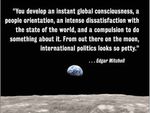Inside the ASP ASTRO BEAT - Astronomical Society of the Pacific
←
→
Page content transcription
If your browser does not render page correctly, please read the page content below
ASTRO BEAT
Inside the ASP
June 2021
Let’s Talk About
Climate Change in
Astronomy
By Travis Rector
University of Alaska Anchorage
ASTROM BEAT any years ago, one day in my solar system astronomy
class, we were talking about the searing hellscape
of Venus. A student asked me, “Is that what climate
Inside the ASP
change is going to do to the Earth?” I assured her the answer
was no- we weren’t going to turn into Venus. But I soon
realized I didn’t really know how to answer her other questions.
What was going to happen to the Earth? How worried should
we be? And what can we do about it? That day, and future
ones, made it clear that many people are deeply concerned
about climate change, and they aren’t getting the information
Figure 1: Earth as seen from Apollo 15 (Image source: NASA1). Apollo 15
they need from other places. And they need to hear it. Climate
astronaut James B. Irwin said: “As we got further and further away, it [the Earth]
change is ravaging my home state of Alaska, in ways that are
diminished in size. Finally it shrank to the size of a marble, the most beautiful
no longer deniable. It is a threat to our economy, our food, our
you can imagine. That beautiful, warm, living object looked so fragile, so delicate,
that if you touched it with a finger it would crumble and fall apart. Seeing this
ways of life. And, no matter where you live, climate change is a
has to change a man.”
threat to yours as well.
AstroBeat No. 179 • June 2021 Page 1But what does of Captain Kirk and
astronomy have Mr. Spock beaming
to do with climate down to an exotic,
change? As it yet strangely familiar,
turns out, a lot. The planet may come to
science of climate mind. Unfortunately
change is woven the term “habitable
into astronomy. zone” does not
For example, the necessarily mean
geologic histories that a planet in this
of Mars and Venus zone is habitable. It
tell chilling stories simply means that
of planets that it could in principle
were oh so close have the right
to being like Earth, conditions for liquid
but then weren’t. water to be on its
They serve as a surface. It doesn’t
warning that planets mean that there
don’t necessarily actually is water,
stay habitable. Of or that there is life,
course the climates of Figure 2: Categories of climate solutions, from Project Drawdown at https://www.drawdown.org. or that we could
Venus and Mars have actually live there.
changed due to natural variations. The Earth’s climate And even if we could, these exoplanets are so far away we
changes naturally too, but on the timescales of many couldn’t possibly relocate to them. Mars at its closest is
thousands of years. Variations in the brightness of the Sun about four light minutes away from us. The nearest star is
are often mistakenly blamed, but scientists now know for over four light years. Compare four minutes to four years
certain that the climate change we’ve experienced over and you’ll get a sense of how much bigger that is. And
the last 100 years or so can only be explained by human we can’t even yet get one human to Mars, much less all
activity, primarily from the burning of fossil fuels. of humanity! It is clear that there truly is “no Planet B.”
And it’s important that everyone knows that we have no
Sometimes people wonder, if things get really bad here choice but to keep Earth’s climate habitable, not just for
on Earth, if we might be able to move to another planet. ourselves but for the plants and animals we rely upon.
The frequent news stories about the discovery of new That is the astronomical message about climate change;
exoplanets, often in so-called “habitable zones,” has led and it is what compels many astronomers, including
to a misconception that there is a wealth of worlds out myself, to take action.
there that we could possibly move to if needed. Pictures
AstroBeat No. 179 • June 2021 Page 2Climate change is a problem that we’ve talked about for
decades, but we no longer have time to wait. To avoid
the worst consequences we need to dramatically reduce
our carbon emissions- cutting them in half over the next
decade and getting to minimal carbon emissions by 2050.
The good news is that we already have the solutions we
need to achieve these goals. We don’t need radical new
technologies. Project Drawdown2 does a wonderful job of
describing the different solutions available to us (see Fig. 2).
And what’s exciting is that these solutions can also make
our lives better.
S
o what can you do to help? Climate scientist Dr.
Katherine Hayhoe has simple advice. Talk about it!
Since climate change can be controversial, you may
be afraid of “starting a fight” by bringing it up. You may also
worry that others don’t care about it, but that’s not the case.
According to surveys by the Yale Program on Climate Change
Communication3, the majority of Americans believe climate
change is happening and is caused by human activity (see Fig.
3). They are also concerned about the risks of climate change.
And they overwhelmingly support policies to address it.
At the same time, two-thirds of Americans say that they
rarely or never talk about the problem. You don’t have
to be an expert on climate change to talk about it. Just
by expressing your concern you’re helping others to do
the same. That can lead to conversations about what we,
collectively and as individuals, can do to solve the problem.
It helps to make the conversation personal. How is it
going to affect you? Most people know climate change
Figure 3: Example of public opinion data from the Yale Program on Climate
is a problem, but few know how it will impact them.
Change Communication, from https://climatecommunication.yale.edu/
visualizations-data/ycom-us/.
The National Climate Assessment Report4 breaks down
the consequences of climate change by region, so it’s a
great resource for learning how your community is being
affected (see Fig. 4).
AstroBeat No. 179 • June 2021 Page 3scientists around the world that shares our astronomical
perspective about the Earth and climate change. In
collaboration with the ASP, we are organizing a Summer
Symposium6 on July 23rd on how you, an astronomy
enthusiast, educator, or professional, can help to address
climate change. I hope you will join us!
Footnotes
1. (page 1): https://commons.wikimedia.org/wiki/File:Apollo_15_Earth1.jpg
2. (page 3): https://www.drawdown.org
3. (page 3): https://climatecommunication.yale.edu/visualizations-data/ycom-us/
4. (page 3): https://nca2018.globalchange.gov
5. (page 4): https://astronomersforplanet.earth
6. (page 4): https://astrosociety.org/get-involved/events/asp2021-summer-
symposium/symposium-overview.html
Figure 4: Example figure from the National Climate Assessment Report (2018,
https://nca2018.globalchange.gov), illustrating impacts in southwestern
You can also use your love of astronomy as an opportunity
to talk about climate change. As I write this, Venus is
visible in the western sky shortly after sunset. It’s a great
opportunity to talk about our sister planet, and the fact it is
over 800°F on its surface because its atmosphere is much
thicker and made almost entirely of carbon dioxide. You
may be surprised how easily that leads to a conversation
about what we’re doing to the Earth’s climate. See a story
about exoplanets? Use it as an opportunity to talk about
what makes our planet special. Talking about space travel?
There are many compelling quotes from astronauts about
how seeing the Earth from space gave them perspective
(see Fig. 1 and its caption, and Fig. 5).
The astronomers perspective is what inspired us to create
the organization “Astronomers for Planet Earth5”, a grass- Figure 5: Another NASA image of the Earth, seen from the Moon, with a quote from
roots organization of astronomy students, educators, and Apollo astronaut Edgar Mitchell.
AstroBeat No. 179 • June 2021 Page 4AstroBeat
Number 179 • June 2021
Publisher: Astronomical Society of the Pacific
Editor: Greg Schultz
Designer: David Barker
One copy of this article may be downloaded on any
single computer and/or printed for your personal,
non-commercial use. No part of this article may be
reproduced in any form, sold, or used in commercial
products without written permission from the
Astronomical Society of the Pacific. For information
about becoming a member, visit here.
The Astronomical Society of the Pacific increases
the understanding and appreciation of astronomy
by engaging scientists, educators, enthusiasts, and
the public to advance science and science literacy.
About the Author
Dr. Travis Rector is a professor
of physics and astronomy at the
University of Alaska in Anchorage. astrosociety.org
He is one of the organizers of the © 2021, Astronomical Society of the Pacific
organization Astronomers for Planet 390 Ashton Avenue, San Francisco, CA 94112
Figure 6: An action shot of the author taking the Earth. He is also the chair of the
cover off of the Swope 1-meter telescope at Las sustainability committee for the
Campanas Observatory. American Astronomical Society. In Give a Stellar Gift
Help foster scientific curiosity, science
these roles he is working to help
literacy and the joy of exploration &
educate people on the causes and
discovery through astronomy … for
consequences of, and solutions to,
tomorrow’s science, technology and
climate change.
academic leaders! Share the gift of
membership in the ASP!
Find out about membership here.
AstroBeat No. 179 • June 2021 Page 5You can also read
























































